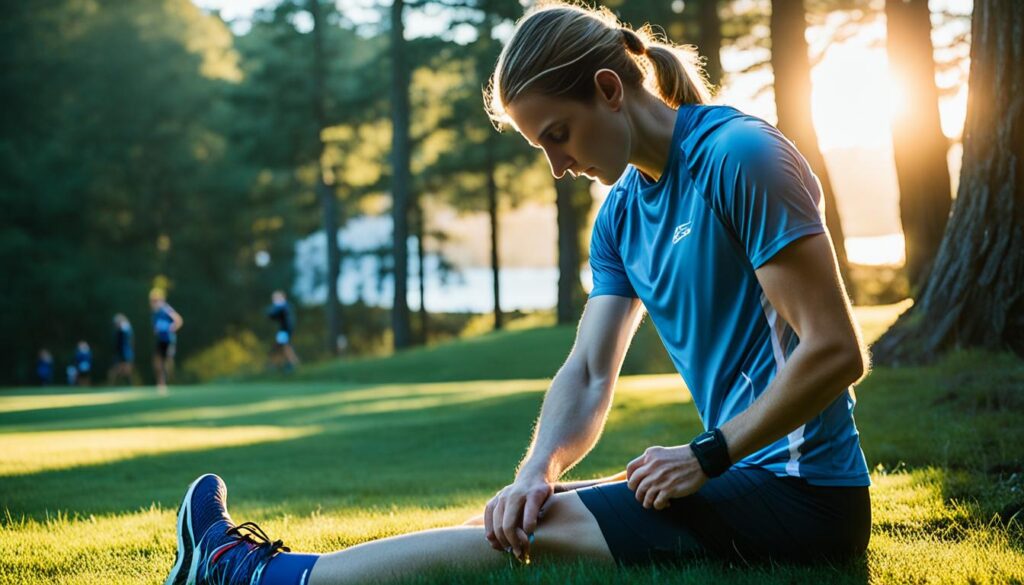Every runner knows that thrilling moment when they finish a race and see their time. These aren’t just numbers. They show your hard work, training, and sometimes tears. Getting a personal record (PR) means so much; it shows how you’ve grown, both in body and mind. When you put on your sneakers for another run, remember how personal records highlight your dedication to getting better at running. No matter if you’re on a track or running through the challenges of cross country, this guide is here to help you reach your next PR, and understand the importance of those accomplishments.
Key Takeaways
- Understanding how to track personal records in running is crucial for your development as an athlete.
- Every PR achieved is a milestone in your running journey, reflecting growth and resilience.
- Both running and cross country present unique challenges that impact your overall performance.
- Incorporating effective training tactics will maximize your potential to improve your PR.
- Strategizing race day focuses not only on speed but also on navigating the course intelligently.
Understanding Personal Records (PRs) in Running
Personal Records, or PRs, are key to your running path. They are your best times for different lengths, in races or training. Runners often track one PR per distance. This is great for PR tracking and seeing how you improve.
Running PRs can cover a range of distances. You might have a best mile time, 5k time, or marathon time. It shows how varied your skills are. Remember, PRs can change based on where you run. You might have a road marathon PR, a cross-country 5k PR, or a trail marathon PR.
Some folks say Personal Best (PB) instead of PR, but it’s a small difference. In the US, we usually say PR for the quickest recorded race time. Canada and the UK often use PB. This shows how important it is to keep accurate records.
Tracking your PRs does two main things. It helps you set goals and keeps you moving forward. When you beat your PR, it’s a big win. If you don’t, it shows you what to work on. Keeping good records lets you set smart goals and celebrate your achievements.
| Types of Running PRs | Description |
|---|---|
| Road 5k PR | Fastest official time for a 5km road race. |
| Track 5,000 meter PR | Fastest recorded time for racing on a track. |
| Cross-Country 5k PR | Best time achieved on a cross-country course. |
| Half Marathon PR | Best time for completing a half marathon. |
| Marathon PR | Fastest official marathon completion time. |
The Importance of Setting a PR
Setting a Personal Record (PR) brings a lot of value to running. It boosts your motivation and helps you perform better. Having a goal, like improving in the 800m, 1600m, or 3200m, makes you more focused.
Making milestones is key in running. Using a strategy, like a positive split in the 800m, helps you do your best. For the 1600m, a good move is to speed up with 500m left to overcome pacing problems.

It’s also important to focus on recovery and getting your mind ready. Sleep and staying hydrated are crucial for doing better. Doing exercises for soft tissue and flexibility, and believing in your training plan helps you meet your goals.
Aiming to beat something like 2:20 in the 800m or knocking 30 seconds off your 5K is important. Mixing your training with speed work and staying positive mentally sets you up for success. Support from friends who run can also really help you go further and reach your PR goals.
what-does-pr-in-running-mean_-what-does-pr-mean-in-cross-country-running
PR stands for Personal Record in running. It’s your best time for a specific distance. It means different things in cross country compared to track running. Track events are on flat, consistent surfaces. Cross country, however, has you racing over hills, across streams, and on uneven paths.
These differences affect your PRs in significant ways. For cross country, the terrain’s challenges mean you need to be strategic. It helps to know the course well. Think about your pacing, where you’ll get water, and how to tackle tricky segments mentally.

Choosing the right race course is crucial for setting a PR. Courses without many hills or sharp turns are generally faster. By understanding these differences, you can tailor your training. This helps you face each challenge effectively.
To hit a new PR, mix speed work and strength training into your prep. Assessing the course carefully is also key. Over time, you might shift your goals because of aging. Maybe you’ll aim for age group records or try new distances. Knowing the ins and outs of PR in running helps you set and reach your goals.
| Aspect | Track PRs | Cross Country PRs |
|---|---|---|
| Course Type | Standardized | Variable Terrain |
| Obstacles | Minimal | Hills, Streams, Uneven Ground |
| Performance Factors | Consistent Conditions | Weather, Terrain |
| Training Focus | Speed Work, Efficiency | Course Strategy, Endurance |
The Historical Context of Cross Country Running
The history of cross country running is full of interesting changes that highlight its importance and growth over time. Digging into its past, we learn what made the sport what it is today. It started in early 1800s England, laying the groundwork for the competitive nature runs we enjoy in the wild.
The Origins in Early 19th Century England
“Hare and Hounds,” a playful chase game from the 1800s, is where it all began. In this game, a ‘hare’ would drop paper to mark a trail for others to follow. Then came organized races like “The Crick Run” in 1837 at Rugby School. These competitions were all about adventure, pushing through different landscapes and overcoming nature’s hurdles. This early start helps us appreciate cross country’s focus on endurance and being able to adjust.
Evolution of Competitive Cross Country Courses
Over time, the design of cross country courses has evolved to meet modern racing’s needs. Initial tough paths became smoother and faster, making races quicker. This change is part of cross country’s broader history, balancing the demand for challenge and efficiency in competition. It shows how the sport keeps evolving, adapting to new standards while staying true to its roots.

Physical Demands of Cross Country vs. Track Running
The differences between cross country and track running are more than meets the eye. Learning about these challenges can make you a better runner. In cross country and track running, the settings and goals create different physical needs.
Challenges Presented by Various Terrain Types
In cross country, the terrain changes a lot. Runners face mud, grass, and hills, affecting how well they do. Their endurance and ability to adjust are tested, improving their skills. Track running, however, happens on predictable and even paths.
Track running’s main challenge is keeping up a fast pace. Cross country runners have to keep their energy up across distances from 3 to 12 kilometers. Races start on a flat piece of 400 to 1,200 meters, then shift to trickier parts. Runners wear special spikes for better grip and stability.
Team vs Individual Focus in Cross Country
Cross country mixes personal effort with teamwork. Runners push themselves but also help their team. Doing well can mean both using smart strategy and aiding teammates. This team spirit boosts motivation and creates a positive space, important for everyone’s success. Track running usually focuses more on individual achievements and personal time goals.

Training Tactics to Help Chase Your PR
To chase personal records, you need good training tactics. Start by building endurance and speed with aerobic conditioning. Adding long runs and intervals will make your aerobic engine stronger.
Building Your Aerobic Engine Effectively
For PRs, a strong aerobic base is key. Aerobic conditioning for runners boosts stamina and gets you ready for races. To grow your aerobic power, try these tips:
- Engage in long runs at a conversational pace to build endurance.
- Incorporate fartlek training sessions to mix speed with endurance.
- Include tempo runs to enhance your lactate threshold, allowing you to sustain faster paces for longer.
Incorporating Strength Training for Injury Prevention
Strength training is also key to avoid injuries. It strengthens your muscles, joints, and tissues, reducing injury risks. To mix strength training with running, remember these points:
- Strength train 5-6 days a week, targeting major muscle groups, particularly those used in running.
- Incorporate bodyweight exercises, resistance bands, or weightlifting to build muscle strength.
- Focus on core stability exercises to enhance your overall balance and running efficiency.

| Type of Training | Frequency | Benefits |
|---|---|---|
| Long Runs | Weekly | Builds endurance |
| Fartlek Training | Weekly | Improves speed and recovery |
| Strength Training | 5-6 days | Prevents injuries |
| Tempo Runs | Bi-weekly | Enhances lactate threshold |
By using these tactics, you’re better prepared for upcoming races. Working on aerobic power and strength is crucial for your running success.
Race Strategies: Competing Beyond Time Goals
Effective race strategy in cross country mixes careful planning with flexible execution. While many athletes look at their finish times, the successful ones see the bigger picture. They focus on tackling their unique courses. By adopting specific course navigation strategies, runners can deal with different terrains and obstacles. This boosts their race day performance.
Focusing on Course Navigation Rather Than Speed
Cross country racing means understanding each course’s unique traits. Athletes plan not just their speed, but how they’ll face different surfaces and changes in elevation. Here are important points for your course navigation:
- Terrain Awareness: Get to know the surface—whether muddy, grassy, or rocky. This helps adjust your steps and energy use.
- Pacing Techniques: Learn when to save energy and when to go all out, based on the course’s layout.
- Turning Adaptations: Work on your agility for sharp turns. This can influence your speed and forward momentum.
- Elevation Management: Gear up for uphill and downhill sections. This prepares your body for what’s coming.
By focusing on course navigation strategies, runners enhance their performance and tackle obstacles better. Adjusting your race strategy for cross country’s specific course elements can improve outcomes.

| Strategy Aspect | Description |
|---|---|
| Terrain Awareness | Adjust stride based on course surface to keep up speed. |
| Pacing Techniques | Manage energy by pacing for hills and flat areas. |
| Turning Adaptations | Master quick and efficient turning techniques to stay fast. |
| Elevation Management | Get ready both physically and mentally for ups and downs. |
How to Prepare for Cross Country Races
To get ready for cross country races, knowing the course and choosing the right gear is key. It helps a lot to learn about the race course before the big day. This knowledge can boost your performance.
The Benefits of Course Familiarization
Getting to know the course does more than just help you not get lost. If you practice on it, you learn about different surfaces like dirt and asphalt. You’ll get used to changes in the course, like hills and tight turns.
Adding workouts that are like the course can make you stronger and more confident. It’s important to get good at running on rough ground. Your training should focus on:
- Long runs
- Tempo workouts
- Interval training
- Recovery runs
Also, practice running uphill and downhill to get ready for any course changes.
Choosing the Right Equipment for Cross Country
Choosing the best gear is very important for doing well in cross country. Picking the right spikes can make a huge difference, depending on the terrain. Starting well helps you get a good spot and run better.
It’s also smart to eat well before the race and check your shoes are tied properly. Be ready for any weather with extra clothes and gear, for cold or muddy conditions.

Assessing Your Performance: More Than Just Times
Assessing your running isn’t just about the times you clock. Think about your race plans and how you’ve grown personally. It’s also about seeing how you deal with race day challenges. Every runner has their own obstacles, like tough courses or the stress of competition.
Looking at the big picture helps you understand how you’re doing. Reflecting on what you’ve learned during training is good. Each race teaches you about your toughness and ability to adapt, which are key for doing well over time.
To get better at assessing your running, try these tips:
- Keep a journal of your training and races to spot trends.
- Work on special workouts aimed at your peak race effort, like doing 5 x 1 km runs at your goal pace for a 5K.
- Set your race goals based on the course layout; for example, a hilly course might mean adjusting your finish time hopes.
Knowing the best pace for long runs is key for good training. Your long run pace should be between 55-75% of your 5K pace. Choose a pace that lets you talk easily to stay in the aerobic zone. Using polarized training, with 80% easy runs, builds a strong base for getting better.

| Training Focus | Typical Pace (% of 5K Pace) | Training Intensity |
|---|---|---|
| Long Runs | 55-75% | Easy |
| Peak Race Intensity Workouts | Goal Pace | Hard |
| Recovery Runs | 70% | Easy |
| Hard Training Sessions | 80-100% | Hard |
Embrace these points, focusing on your whole running journey, not just times. Every race and workout is a chance to grow athletically. They weave together skills and experiences that make you a better runner.
Conclusion
We’ve come to the end of our journey through the world of running PRs and cross country. By understanding its history and modern strategies, you can run smarter and with more confidence. It’s not just about knowing tricks; it’s about a deeper grasp of the sport.
Chasing personal records goes beyond just the times you achieve. It’s really about improving your journey in running. Using tips like tapering and building stronger legs will help you grow. You’ll become both a better runner and a more developed person. Always keep your eyes on your goals, especially when working on improving your PRs. This way, you make every run count and enjoy the journey as well.
The excitement of cross country racing is in its challenges and the rewards they bring. By diving into the training and competitive aspects we discussed, you’ll improve your running and find joy in it. As the sport changes, every run is a chance to aim for a new personal best.









